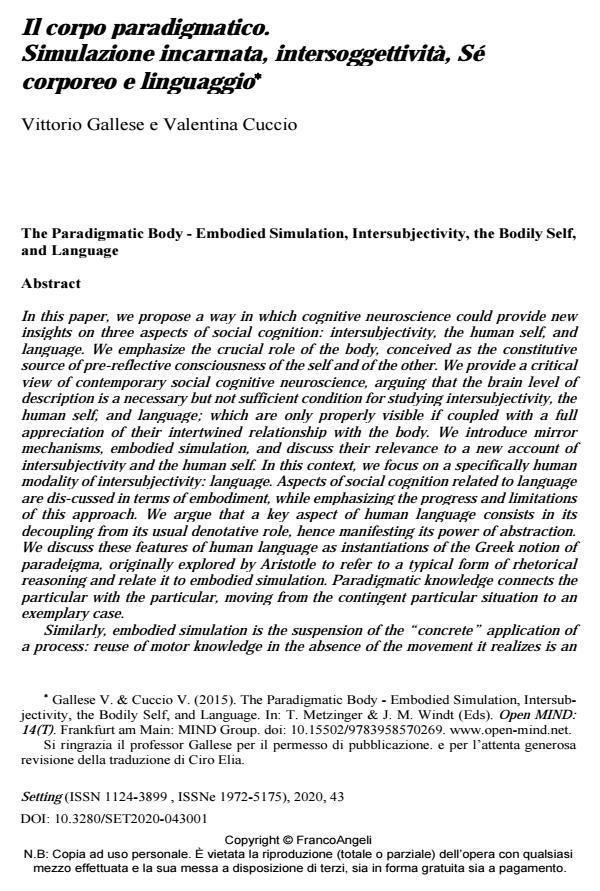Il corpo paradigmatico. Simulazione incarnata, intersoggettività, Sé corporeo e linguaggio
Titolo Rivista SETTING
Autori/Curatori Vittorio Gallese, Valentina Cuccio
Anno di pubblicazione 2020 Fascicolo 2020/43
Lingua Italiano Numero pagine 40 P. 5-44 Dimensione file 399 KB
DOI 10.3280/SET2020-043001
Il DOI è il codice a barre della proprietà intellettuale: per saperne di più
clicca qui
Qui sotto puoi vedere in anteprima la prima pagina di questo articolo.
Se questo articolo ti interessa, lo puoi acquistare (e scaricare in formato pdf) seguendo le facili indicazioni per acquistare il download credit. Acquista Download Credits per scaricare questo Articolo in formato PDF

FrancoAngeli è membro della Publishers International Linking Association, Inc (PILA)associazione indipendente e non profit per facilitare (attraverso i servizi tecnologici implementati da CrossRef.org) l’accesso degli studiosi ai contenuti digitali nelle pubblicazioni professionali e scientifiche
In questo articolo proponiamo una modalità con cui la neuroscienza cognitiva può fornire nuovi insight su tre aspetti della cognizione sociale. Intersoggettività, Sé umano e linguaggio. Sottolineiamo il ruolo sociale del corpo, concepito come sor-gente costitutiva della coscienza preriflessiva del Sé e degli altri. Intendiamo fornire una visione critica della neuroscienza contemporanea cognitiva e sociale e soste-niamo che il livello neurofisiologico di descrizione è condizione necessaria ma non sufficiente per lo studio dell’intersoggettività, del Sé umano e del linguaggio; questi elementi possono essere chiaramente comprensibili solo in collegamento ad un pie-no riconoscimento della loro stretta inter-relazione con il corpo. Prenderemo in esame i meccanismi specchio e la simulazione incarnata per la loro importanza per una nuova concettualizzazione dell’intersoggettività e del Sé umano. In questo con-testo ci focalizzeremo su una forma specificamente umana di intersoggettività: il linguaggio. Discuteremo gli aspetti della cognizione sociale legati al linguaggio in termini di incarnazione, sottolineando sia il carattere innovativo sia i limiti di que-sto approccio. Sosterremo che un aspetto chiave del linguaggio umano consiste nel disaccoppiamento dal suo usuale uso denotativo, che ne manifesta la capacità di astrazione. Discuteremo queste caratteristiche del linguaggio umano come esempli-ficazione della nozione greca di paradeigma, originariamente studiata da Aristote-le, per riferirci ad una forma tipica di argomentazione retorica e per collegarla alla simulazione incarnata. La conoscenza paradigmatica connette il particolare al par-ticolare, passando da una particolare situazione contingente al caso esemplare. Al-lo stesso modo, la simulazione incarnata consiste nella sospensione dell’applicazione concreta di un processo: la riutilizzazione della conoscenza moto-ria in assenza di movimento che essa realizza è un esempio di "conoscenza paradig-matica". Questo nuovo approccio epistemologico all’intersoggettività consente la possibilità di previsioni circa la natura intrinsecamente funzionale delle nostre ope-razioni cognitive sociali, andando oltre e senza subordinazione ad una specifica ontologia della mente.
Parole chiave:Neuroscienza cognitiva, simulazione incarnata, intersoggettività, linguaggio, neuroni specchio, paradigma, cognizione sociale.
Vittorio Gallese, Valentina Cuccio, Il corpo paradigmatico. Simulazione incarnata, intersoggettività, Sé corporeo e linguaggio in "SETTING" 43/2020, pp 5-44, DOI: 10.3280/SET2020-043001